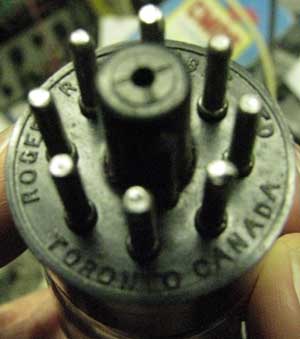6X6 functionally different from other round eye tubes
6X6 functionally different from other round eye tubes
Fellow Radiophiles:
The 6X6 pinout and function have been incorrectly reported shortly after it's introduction in 1937. [Ludwell Sibley, “A Bit More on Rogers,” Tube Collector, April 2000, p. 16 (6X6 tube)]
The 6X6 is not functionally equivalent to other round eye tubes like the 6G5/6E5 or 6U5.
Ed Lyon has also reported on this error [Ed Lyon, "Wide-Shadow-Angle Tuning Indicator Tubes", Radio Age, January 2003, p. 7]. The 6X6 has a very wide deflection angle between 0o with the eye closed, and nearly 180o, with the eye wide open. Ed's article also explores in detail how to widen the 90o deflection angle of the very common round eye tubes 6G5/6E5, to 160o, with the addition of an external triode, such as the 76. Ed's application follows an RCA application note from 1937. This application note was also published in Radio World, February 1938 p. 19.
The functional difference of the 6X6 from other round tuning eye tubes is that the input triode has an independent cathode that may remain grounded with respect to the AVC control signal, while the CRT section has a separate cathode that is optimally biased at a higher voltage (>+45V) for a wider deflection angle.
Keeping the CRT cathode at pin 6 in the 6X6 biased at a high voltage makes it possible for the deflection anode to be pulled below the CRT cathode, toward the triode cathode, which sits at ground level. When the deflection anode at pin 3 is pulled below the CRT cathode at pin 6, the delection widens to nearly 180o.
The correct 6X6 OCTAL pinout that appears frequently in Rogers-Majestic radio schematics is:
1-NC
2-Heater
3-Triode plate and CRT deflector
4-Fluorescent target anode for CRT
5-input triode control grid
6-CRT cathode run at ~45VDC
7-Heater
8-Input triode cathode
Regards,
-Joe
To thank the Author because you find the post helpful or well done.
2 different 6X6 versions !

Dear Joe,
apparently there are two different versions of 6X6 eye tubes existing, - the one you are talking about versus the one shown here on the RM page.
This red painted Haltron 6X6 is of the same design as other single-shadow-angle tuning indicators such as the 6E5 and has just the same narrow deflection angle.
It can't impossibly have an independent cathode on its input triode, since pin 6 is omitted on the base, as clearly visible at the picture.
I can simply replace the Haltron 6X6 by a Vi103 without any remarkable difference.
Best Regards, Jacob
To thank the Author because you find the post helpful or well done.
Detailed photos of the dual cathode 6X6
Fellow Radiophiles:
The Rogers 6X6 mystery stimulated an international and intercontinental search that finally revealed the history of the this exceptional round eye tube. This exchange included Ed Lyon, Ludwell Sibley, Brian Belanger, Jacob Roschy, Howard Mariotti, Roy Johnson, Bill Courtright, Lea Barker, Gordon Rabjohn and Steve Rizewski. Jacob Roschy has updated the Rogers 6X6 tube page with these findings.
Steve Rizewski lent his rare specimen of this tube to fellow Ottawa Vintage Radio Club Gordon Rabjohn for photographing and electrical investigation. Lea Barker was Ed Lyon's link at the Ottawa Vintage Radio Club.
I include here a converted power point presentation that Gordon Rabjohn kindly sent to report his findings on the 6X6G.
The 6X6
Gord Rabjohn

 Hard to see, but the indicator cathode is brought down to the pinch with a fine “insulated” wire, looks like a filament!
Hard to see, but the indicator cathode is brought down to the pinch with a fine “insulated” wire, looks like a filament!




.gif)
Thank you all for the contributions to solve the 6X6 mystery.
Regards,
-Joe
To thank the Author because you find the post helpful or well done.


